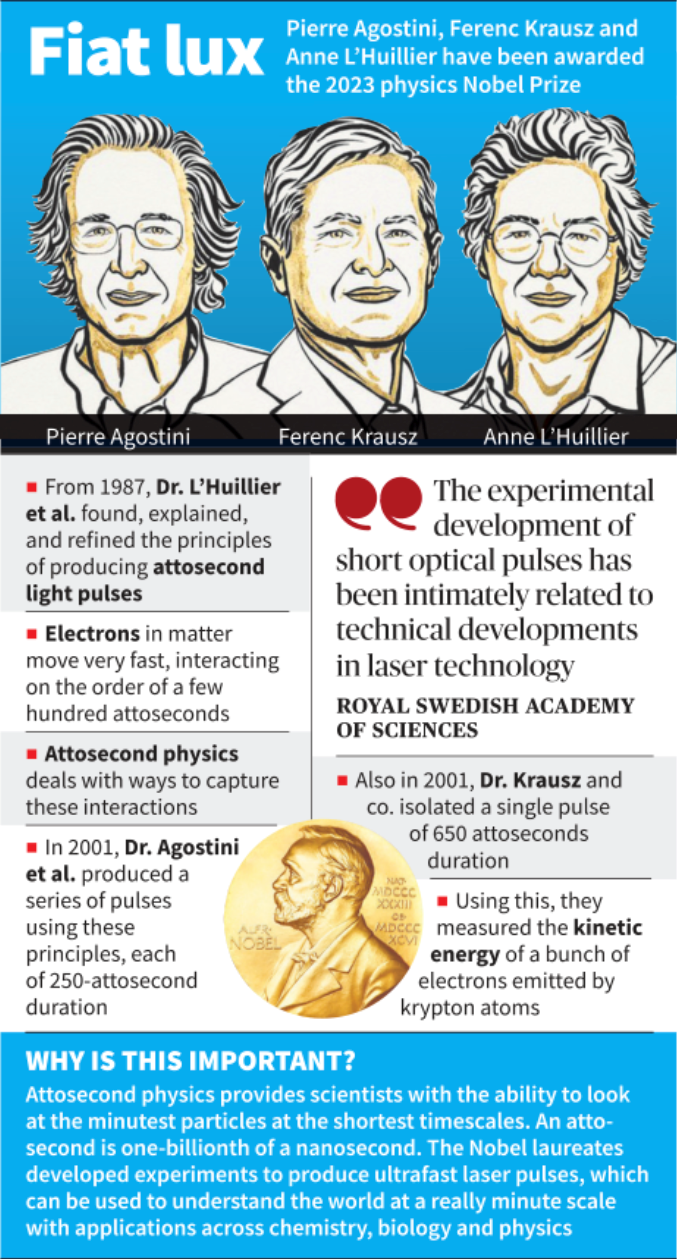Description

Disclaimer: Copyright infringement not intended.
Context
The Nobel Prize in Physics for 2023 has been awarded to Pierre Agostini, Ferenc Krausz, and Anne L’Huillier for their pioneering work in the field of attosecond physics.
Details
This revolutionary research has enabled scientists to delve into the ultrafast dynamics of electrons inside atoms and molecules, uncovering phenomena that were previously beyond the realm of observation.
Understanding Attosecond Physics
- Attosecond physics involves the study of processes occurring at timescales on the order of attoseconds, which are billionths of a billionth of a second (10^-18 seconds).
- In comparison, femtoseconds (10^-15 seconds) were previously considered the limit for observing ultrafast events at atomic and subatomic scales.
Achievements of the Laureates
- Pierre Agostini, Ferenc Krausz, and Anne L’Huillier have been recognized for their groundbreaking work in generating attosecond pulses of light.
- These attosecond pulses are incredibly short bursts of light that allow scientists to capture and study phenomena occurring at the subatomic level with unprecedented precision.
- Atoms and molecules undergo rapid movements and changes on timescales measured in attoseconds, and this research has made it possible to observe and comprehend these ultrafast behaviors.

Comparison to High-Speed Photography
- Attosecond physics can be likened to using high-speed photography to slow down and analyze processes too fast for the human eye to perceive.
- It enables scientists to "freeze" and examine subatomic motions, akin to capturing every frame of a rapidly moving object
Historic Achievement
- Anne L’Huillier's inclusion as a Nobel laureate marks a significant milestone as she becomes only the fifth woman to receive the Nobel Prize in Physics since its establishment in 1901.
- This recognition highlights the importance of gender diversity in the field of physics.
Potential Applications
- Attosecond science holds immense potential across multiple scientific domains, including physics, chemistry, biology, electronics, and medicine.
- In medicine, it can be applied to cancer therapy research and other medical diagnostics.
Complementary Nobel Prizes in Related Fields
- Previous Nobel Prizes in related fields, such as the 1998 Nobel Prize in Chemistry awarded to Ahmed Zewail for femtosecond spectroscopy and the 2018 Nobel Prize in Physics for breakthroughs in laser physics, underline the growing significance of ultrafast science.
Understanding Subatomic Dynamics
- Electrons, the subatomic particles that orbit atomic nuclei, exhibit dynamics that occur at timescales significantly faster than those of the atoms and molecules themselves.
- Attosecond physics provides the tools needed to observe and manipulate these electron dynamics, advancing our understanding of the subatomic world.
.jpg)
Conclusion
Nobel Prize in Physics for 2023 celebrates the groundbreaking achievements of Pierre Agostini, Ferenc Krausz, and Anne L’Huillier in attosecond physics. Their research has ushered in a new era of scientific exploration, enabling us to witness and understand the ultrafast dynamics of electrons within atoms and molecules, with profound implications for the advancement of various scientific disciplines and technologies.
|
PRACTICE QUESTION
Q. Discuss the significance of the Nobel Prize in Physics 2023 awarded to Pierre Agostini, Ferenc Krausz, and Anne L’Huillier for their contributions to attosecond physics. Explain the principles of attosecond physics, its applications, and its potential implications for scientific advancements. (250 Words)
|
















